A FIELD METHOD FOR AGE ESTIMATION OF
MEDITERRANEAN MONK SEAL PUPS
Panayiotis Dendrinos, Eleni Tounta & Spyros Kotomatas
MOm/Hellenic Society for the Study and Protection of the Monk Seal
18 Solomou str., GR-106 82 Athens, Greece
Abstract
In 1990, a long-term program was established in order to monitor the status of the Mediterranean monk seal (Monachus monachus) population within the National Marine Park of Alonnissos, Northern Sporades, Greece. The methodology used for monitoring the population consisted of surveying all 35 seal-shelters found within the study area. Especially during the breeding season (July - December), the frequency of the surveys and the ability to exhaustively cover all shelters within a 24 hour period, provided the opportunity to estimate the date of birth (+/- 5 days) of each newborn pup encountered.
During the study period (1990 - 1998), 243 different encounters with monk seal pups were recorded. From these observations, 56 different individual newborn pups were identified and monitored during the first months of their development. In 71 cases, involving 27 different pups, external morphological features and their modification over time were recorded. These features are: the existence of the umbilical cord and/or the status of the umbilicus, the condition of the fur and the condition and shape of the animal's body. Based on these features and on their variation in relation to the increasing age of the animals, the data collected were categorized into four distinct morphological/age classes:
- Thin-newly born / age 0-10 days old
- Spindle-wooly coat / age 10-30 days old
- Spindle-patchy coat (molting) / age 30-50 days old
- Fat-short coat (fully molted) / age 50+ days old
The above classes may be used as a field method for age estimation of newborn pups, that could be applied in other areas of the species' range. An important element of such noninvasive methodology is that it can be applied from a distance, not requiring handling or restraining of the animals.
Introduction
The Mediterranean monk seal (Monachus monachus) is considered to be a critically endangered species (IUCN, 1996). Its world population consists of several hundred individuals, while in Greece, based on data from sections of the country's coastline, it has been estimated that approximately 250 animals are found. The area of N. Sporades islands, N. Aegean, Greece, holds one of the largest breeding monk seal populations. In 1992 the area was officially declared a National Marine Park. The protected area covers 2200 km2 and includes 17 islands, most of which are uninhabited.
In 1990, a long-term program was established in order to monitor the status of the monk seal population in the area (HSSPMS, 1995). An important part of this program was to monitor the newborn pups in the area and especially to identify them individually, to estimate the population's annual productivity, to determine the distribution of births in time and space and to collect data on the development and behavior of monk seal pups during the first months of their life. From the data collected through this work, it became evident that a non-invasive field method for estimating the age of newborn pups could be developed.
Methods
The methodology used for monitoring the seal population consisted of surveys of all 35 different shelters found within the study area (Dendrinos et al, 1996) Especially during the breeding season (July - December) the frequency of the surveys and the ability to exhaustively cover all monk seal shelters within an island in a very short time (1-2 hrs) provide the opportunity to estimate the date of birth of each newborn pup encountered within a 10 day range. Direct observations, the use of photographic cameras by the researchers during the surveys, and the application of pre-programmed automatic cameras, installed in several shelters within the study area, provided the data used for the identification of individual pups. The fact that all newborn pups encountered exhibited dark body coloration with a characteristic unique in shape, yellowish-white patch on the abdomen allowed the accurate identification of all pups in the study area.
Results
During the study period (September 1990 - December 1998) 243 different encounters with monk seal pups were recorded. From the analysis of the above data 56 different individual newborn pups were identified and monitored during the first months of their development. During this study it became evident that monk seal pups exhibit a distinct change in their overall external morphology which varied in accordance with their age. The external features that were found to vary with time and which are possible to observe from a distance, are the condition of the animal's fur, the condition and shape of the animal's body and the existence of its umbilical cord and/or the status of its umbilicus. From the 243 observations, in 71 cases, involving 27 different pups, all the above morphological features were observed and recorded and thus only these cases were used in the development of the field age estimation method.
Based on these morphological features and on their variation through the age of the animals, all pups observed could be classified into the following morphological categories:
|
Stage A
Thin-Newly Born. Age: 0-10 Days Old
Pups in this age category were observed 27 different times. In all cases their fur appearance was characterized by having the typical dark colored lanugo fur (long wooly coat of 2cm length) but the texture of the hair is in clumps and has a wet appearance even when dry. The patch in the belly area in the animals of this age appears yellowish-orange in coloration, possibly due to the amniotic fluids. In terms of the animal's body shape, it appears skinny, in such a way that the skeletal features (skull, neck, scapula-humerus joint and the femur-tibia/fibula joint) are visible. Furthermore, in all cases part of the umbilical cord was still attached to the abdomen or the umbilicus was still not healed completely having a fresh pink coloration. |
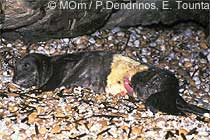 |
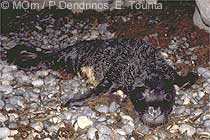 (Click on image to enlarge) (Click on image to enlarge)
|
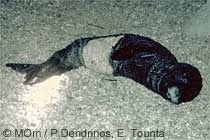 |
|
Stage B
Spindle-Wooly Coat. Age: 10-30 Days Old
Pups in this age category were observed 15 different times. With respect to their fur, they also had the dark gray to black lanugo fur, but its appearance and texture was wooly, even and fluffy when dry. Even when wet it still had an even and uniform appearance. The patch of the animal did not change in shape but the coloration became yellowish white. The body became clearly spindle shaped, and well rounded, while the skeletal features (neck, scapula-humerus joint and the femur-tibia/fibula joint) were no longer evident. In all the cases when the abdomen of the animals was evident, the umbilical cord had dropped and the umbilicus was healed. |
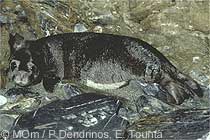 |
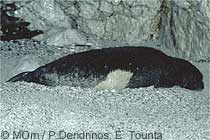 (Click on image to enlarge) (Click on image to enlarge)
|
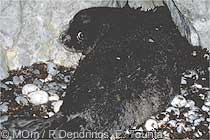 |
|
Stage C
Spindle-Patchy Coat. Age: 30-50 Days Old
Pups of this age were observed on 16 different occasions. The animals observed were undergoing their fur molt. The appearance of their fur was very irregular and patchy, since parts of their body were covered by the lanugo, while others were covered by the new fur (shorter in length and lighter in coloration). Relative to their body shape, all the animals observed exhibited again the spindle shape and were well rounded and their umbilicus was completely healed. In only one of the cases observed, an animal 40-50 days old had similar to the above features but its body shape was so round and fat that it appeared as bloated, a characteristic which was commonly observed in the next age group. |
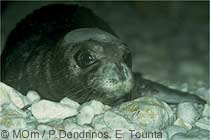 |
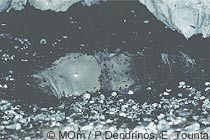 (Click on image to enlarge) (Click on image to enlarge)
|
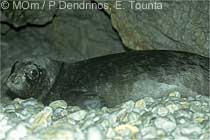 |
|
Stage D
Fat-Short Coat. Age: 50+ Days Old
Animals of age more than 50 days old were observed on 13 different occasions. In all these cases the animals had similar appearance. They had completed their molt and were covered by a new short fur, of grayish coloration, dark dorsally and distinctly lighter ventrally. Their bodies were more developed and fat, giving the impression of being bloated. It is of interest to note that in the animals of this age, the characteristic abdominal patch is less distinct and is clearly identifiable only at the lateral borders where it meets the dark dorsal coloration. In certain cases it appears that the patch has completely faded away. This overall appearance may remain as such for several months, since in certain cases where animals of 4 to 5 months in age were observed, they exhibited all the above morphological characteristics. |
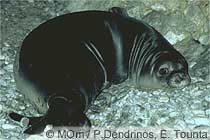 |
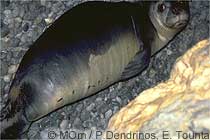 (Click on image to enlarge) (Click on image to enlarge)
|
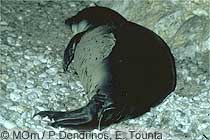 |
|
Conclusion
The above four distinct morphological categories, that appear consecutively as a monk seal newborn pup develops, form a relatively easy to use field method for estimating the age of pups. Such a method may be quite useful for researchers in cases where no additional information is available with respect to the individual history of an animal. The fact that this methodology is not invasive, since it is based on visual and photographic evidence, and does not require the handling or restraining of the animals, provides an additional advantage to its use in the field.
References
Dendrinos, P., S. Kotomatas & E. Tounta. 1996. Monk seal pup production in the National Marine Park of Alonissos-N.Sporades. In: International Zoological Congress of the Hellenic Zoological Society, Athens, Greece, April 1996: 1-8.
HSSPMS. 1995. Continuation of the monitoring of the monk seals in the National Marine Park of the Northern Sporades. Final report for the European Commission Project 4-3010(92)7829.
IUCN. 1996. 1996 IUCN red list of threatened animals. The IUCN Species Survival Commission. International Union for Conservation of Nature and Natural Resources, Gland, Switzerland: 1-368 + 10 annexes.
This project was partially funded by the European Commission, D.G. XI, by the Contracts No. 6610(90)9165 and 4-3010(92) 7829 and the LIFE-Nature B4-3200/96/500.
|
|
This poster was presented at the 13th Biennial Conference on the Biology of Marine Mammals, Maui, Hawaii, 28 November-3 December 1999
|





Copyright © 2000 MOm, P. Dendrinos, E. Tounta, S. Kotomatas, The Monachus Guardian. All Rights Reserved


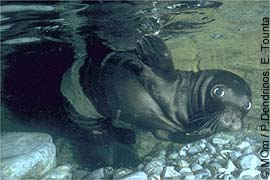
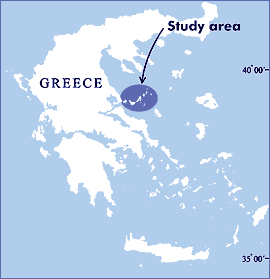

 (Click on image to enlarge)
(Click on image to enlarge)

 (Click on image to enlarge)
(Click on image to enlarge)

 (Click on image to enlarge)
(Click on image to enlarge)

 (Click on image to enlarge)
(Click on image to enlarge)